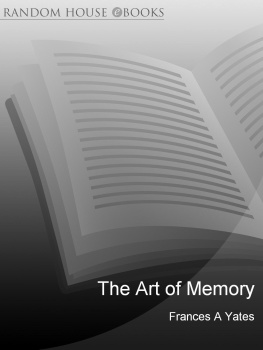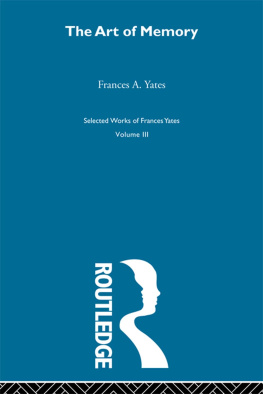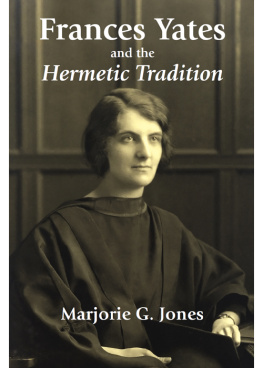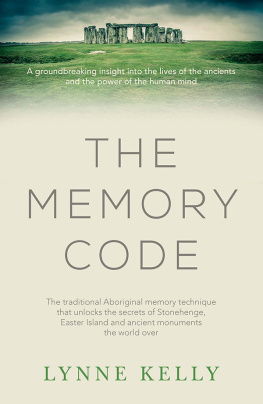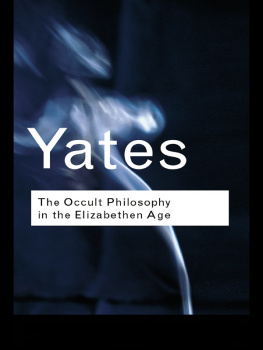About the Book
The Ancient Greeks, to whom a trained memory was of vital importance as it was to everyone before the invention of printing created an elaborate memory system, based on a technique of impressing places and images on the mind. Inherited and recorded by the Romans, this art of memory passed into the European tradition, to be revived, in occult form, at the Renaissance, and particularly by the strange and remarkable genius, Giordano Bruno.
Such is the main theme of Frances Yatess unique and brilliant book, in the course of which she sheds light on such diverse subjects as Dantes Divine Comedy, the form of the Shakespearian theatre and the history of ancient architecture. Aside from its intrinsic fascination, The Art of Memory is an invaluable contribution to aesthetics and psychology, and to the history of philosophy, or science and of literature.
About the Author
Dame Frances Yates (18991981) achieved a world-wide reputation as an historian. Her close association with the Warburg Institute of the University of London began shortly after the Second World War, after the publication of her first two books. She was Reader in the History of the Renaissance there until 1967, when she became an Honorary Fellow. As well as gaining many academic honours, she was awarded the OBE in 1977 and was made DBE in the same year. Her publications include Giordano Bruno and the Hermetic Tradition, Theatre of the World, The Rosicrucian Enlightenment, Astraea, Shakespeares Last Plays and The Valois Tapestries.
THE ART
OF MEMORY
FRANCES A. YATES
This ebook is copyright material and must not be copied, reproduced, transferred, distributed, leased, licensed or publicly performed or used in any way except as specifically permitted in writing by the publishers, as allowed under the terms and conditions under which it was purchased or as strictly permitted by applicable copyright law. Any unauthorised distribution or use of this text may be a direct infringement of the authors and publishers rights and those responsible may be liable in law accordingly.
Version 1.0
Epub ISBN 9781448104130
www.randomhouse.co.uk
PIMLICO
20 Vauxhall Bridge Road, London SW1V 2SA
London Melbourne Sydney Auckland Johannesburg
and agencies throughout the world
First published by Routledge & Kegan Paul 1966
Pimlico edition 1992
Reprinted 1994 (twice), 1996, 1997, 1999 (twice),
2000 (twice), 2001, 2003, 2005, 2006, 2007, 2008 (twice), 2010
The Estate of Francis A. Yates 1966
This book is sold subject to the condition that it shall not, by way of trade or otherwise, be lent, resold, hired out, or otherwise circulated without the publishers prior consent in any form or binding or cover other than that in which it is published and without a similar condition including this condition being imposed on the subsequent purchaser.
ISBN 978-0-7126-5545-3
CONTENTS
ILLUSTRATIONS
PLATES
Hermetic Silence. From Achilles Bocchius, Symbolicarum quaestionum libri quinque, Bologna, 1555. Engraved by G. Bonasone
The Wisdom of Thomas Aquinas. Fresco by Andrea da Firenze, Chapter House of Santa Maria Novella, Florence (photo: Alinari)
Justice and Peace. Fresco by Ambrogio Lorenzetti (detail), Palazzo Pubblico, Siena (photo: Alinari)
Envy
Frescoes by Giotto, Arena Capella, Padua (photos: Alinari)
Temperance, Prudence
Justice, Fortitude
From a Fourteenth-century Italian Manuscript, Vienna National Library (MS. 2639)
Penance, From a Fifteenth-century German Manuscript, Biblioteca Casanatense, Rome (MS. 1404)
Abbey Memory System
Images to be Used in the Abbey Memory System.
From Johannes Romberch, Congestorium artificiose memorie, ed. of Venice, 1533
Grammar as a Memory Image
Visual Alphabets Used for the Inscriptions on Grammar
From Johannes Romberch, Congestorium artificiose memorie, ed. of Venice, 1533
Hell as Artificial Memory
Paradise as Artificial Memory
From Cosmas Rossellius, Thesaurus artificiosae memoriae, Venice, 1579
The Places of Hell. Fresco by Nardo di Cione (detail), Santa Maria Novella, Florence (photo: Alinari)
Titian, Allegory of the Three Parts of Prudence (National Gallery)
Palladios Reconstruction of the Roman Theatre. From Vitruvius, De architectura cum commentariis Danielis Barbari, ed. of Venice, 1567
The Teatro Olimpico, Vicenza (photo: Alinari)
Ramon Lull with the Ladders of his Art. Fourteenth-century Miniature, Karlsruhe (Cod. St Peter 92)
Memory System Based on Giordano Brunos De umbris idearum (Shadows), Paris, 1582
Images of the Decans of Aries
Images of the Decans of Taurus and Gemini
From Giordano Bruno, De umbris idearum (Shadows), ed. of Naples, 1886
Pictures illustrating the Principles of the Art of Memory. From Agostino del Riccio, Arte della memoria locale, 1595, Biblioteca Nazionale, Florence (MS. II, I, 13)
The Heaven
The Potters Wheel
Seals from Brunos Triginta Sigilli etc.
Memory System from Brunos Figuratio Aristotelici physici auditus, Paris, 1586
Memory System from Brunos De imaginum compositione, Frankfort, 1591
First Page of the Ars memoriae in Robert Fludds Utriusque Cosmi Historia, Tomus Secundus, Oppenheim, 1619
The Zodiac. From Robert Fludds Ars memoriae
The Theatre. From Robert Fludds Ars memoriae
Secondary Theatre
Secondary Theatre
From Robert Fludds Ars memoriae
The De Witt Sketch of the Swan Theatre. Library of the University of Utrecht
Sketch of the Stage of the Globe Theatre based on Fludd
FIGURES
The Spheres of the Universe as a Memory System. From J. Publicius, Oratoriae artis epitome, 1482
The Spheres of the Universe as a Memory System. From J. Romberch, Congestorium artificiose memorie, ed. of 1533
Human Image on a Memory Locus. From Romberch, Congestorium artificiose memorie, ed. of 1533
The Ladder of Ascent and Descent. From Ramon Lulls Liber de ascensu et descensu intellectus, ed. of Valencia, 1512
A Figure. From R. Lulls Ars brevis (Opera, Strassburg, 1617)
Combinatory Figure. From Lulls Ars brevis
Tree Diagram. From Lulls Abor scientiae, ed. of Lyons, 1515
Memory Wheels. From G. Bruno, De umbris idearum, 1582
Diagram of Faculty Psychology. Redrawn from a diagram in Romberch, Congestorium artificiose memorie
Memory Theatre or Repository. From J. Willis, Mnemonica, 1618
Suggested Plan of the Globe Theatre
Folder: The Memory Theatre of Giulio Camillo
PREFACE
T HE subject of this book will be unfamiliar to most readers. Few people know that the Greeks, who invented many arts, invented an art of memory which, like their other arts, was passed on to Rome whence it descended in the European tradition. This art seeks to memorize through a technique of impressing places and images on memory. It has usually been classed as mnemotechnics, which in modern times seems a rather unimportant branch of human activity. But in the ages before printing a trained memory was vitally important; and the manipulation of images in memory must always to some extent involve the psyche as a whole. Moreover an art which uses contemporary architecture for its memory places and contemporary imagery for its images will have its classical, Gothic, and Renaissance periods, like the other arts. Though the mnemotechnical side of the art is always present, both in antiquity and thereafter, and forms the factual basis for its investigation, the exploration of it must include more than the history of its techniques. Mnemosyne, said the Greeks, is the mother of the Muses; the history of the training of this most fundamental and elusive of human powers will plunge us into deep waters.

